This was in 1953. My stepfather was sent by the district committee to a lagging collective farm - to raise the farm there, and the whole family moved to live in one of the villages. Near the house where we settled, there was a collective farm forge. Once, out of curiosity, I went to see what it was, and was shocked by what I saw. From the outside, the forge looked like a pile of smoldering logs. I still remember this building, black from soot and dust, with an earthen floor, a small dim window and large wooden gates. Smoke covered the entire room, only rays of light made their way through the cracks in the walls and roof. In the far corner stood a huge structure of brick and metal, inside of which a large fire burned with a bright fire and acrid smoke. Pieces of iron, old horseshoes, sledgehammers and some incomprehensible devices were scattered on the floor. In the center, on a large rickety stump, stood a huge anvil, all beaten with hammers and chisels, against the wall, on a smaller stump, blacksmith's vise was attached, and on a bench by the window sat three grimy peasants of indeterminate age ... Since then, I often stopped by to this forge, the magic of fire and red-hot iron fascinated me so much.
I kept my interest in visiting forges for many years: I talked with blacksmiths, watched their work.
What is a forge?
So, we begin the first lesson, which is dedicated directly to the forge, its device and equipment. What is a forge? In a nutshell, this is a room equipped for blacksmithing. And if you approach this issue creatively, then the forge for a blacksmith who is passionate about his work is not just a room, it is his house, his temple, in which all kinds of miracles take place. In the forge, the master spends almost all his time. Here he works, rests, creates, thinks. It was said that my grandfather used to compose poetry while working, and my good friend Andrzej Dajkowski, a blacksmith from Gdansk, sings arias from operas together with his assistants. Many different events can happen to a person in a forge.
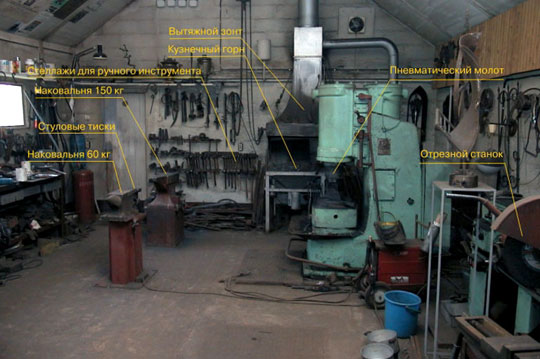
Undoubtedly arrange it easier themes who lives in the countryside has little household plot or give. In the city, this is quite difficult to do, except for those cases when the master works at the factory and is somehow connected with the factory forge, where there is necessary equipment. By the way, I’ll make a reservation right away: if someone masters a craft in order to get rich, drop this idea. Neither in Russia, nor in other countries, I do not know a single good blacksmith who would earn big money.
Work in the forge constantly requires the help of one or two assistants, so try to find like-minded friends right away. True, I have been working alone for many years, showing miracles of ingenuity: instead of a hammer, I have a pneumatic hammer, as helpers - various devices.
For those who want to comprehend all the intricacies of blacksmithing (I emphasize, it is arts, not crafts) - both novice blacksmiths and those who have been working for a long time, I advise you to immediately begin to engage in fine arts. For young people I recommend an art school, an art studio, a drawing circle, those who are older and more experienced can take lessons from professional artists. The ideal option would be to receive a special art education. It is necessary to study the technique and laws of drawing, painting and composition. Without this knowledge, it is impossible to become a real expert in artistic forging. However, being a competent artisan is also not bad - today there is an acute shortage of professional craftsmen.
Altar in the temple
To organize a forge, you need to select or build a room. Its dimensions may vary, but the design itself and Construction Materials must fully comply with all fire safety standards and regulations. It is very serious! You can put the forge on outdoors by arranging a small canopy near the barn or garage. My first forge was under open sky at the end of the garden, I will say that it caused a lot of inconvenience in rainy and cold weather.
Organize workplace and everyone can install equipment at their own discretion, there are no hard and fast rules for this. In the following, I will give several layout options as an example.
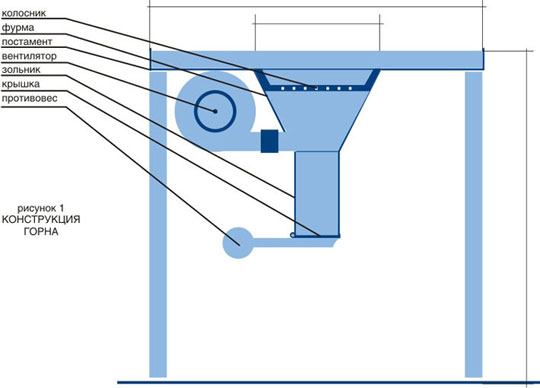
Now let's move on to the forge equipment. If a forge is a temple, then the altar in that temple is a forge. It is in the forge that the mystery of turning steel into a soft and pliable material takes place. The principle of operation of a classic blacksmith's forge is extremely simple. A small pile of coal burns on the working surface of the furnace - steel billets are placed here, which are heated to the temperature required for forging. Currently, there are a huge number of designs of forges. Basically, they differ in the type of fuel. There are forges on solid fuel - this is coal and charcoal, coke, in extreme cases, you can use simple firewood. I prefer coke, although it is more expensive than plain lignite or anthracite. But in terms of its quantity, about five times less is required; during combustion, coke gives a higher temperature, there is no soot and less slag. It is best to use small coke ("coke") - large foundry coke has to be pricked, it takes a lot of time. There are furnaces for liquid and gas fuels, but they are mainly used in large industries. True, at present, the English company EFM has launched the production of small stationary and portable forges powered by liquefied propane. This forge is very similar to the classic charcoal, but instead of coal, small pieces of special ceramics are used, which are heated gas burner. A significant drawback of such a forge is its high cost (about 2000 English pounds) and high gas consumption.
Let us consider in more detail the design of a simple coal hearth (Fig. 1). Such a horn can be made by yourself or ordered at the factory. The basis of a stationary hearth is a table, the top cover serves to place the hearth and heated workpieces. The height of the table is determined by the height of the blacksmith and can be equal to 700-800 mm. The size of the horizontal surface, in principle, can be any, but usually it is 800x800 mm or 1000x1500 mm. In the center of the table there is a hearth nest, which consists of a tuyere and a grate - air is supplied through them for burning coal. Traditionally, the table top was laid out with refractory bricks on clay, but this complicates and weighs the whole structure. I have been using an all-metal forge with a stainless steel lid for many years. steel sheet 4 mm thick, in the center of which there is a cast-iron grate. The grate can be made from an old cast-iron thick-walled frying pan with a diameter of 200-300 mm, it is enough to drill holes with a diameter of 8-10 mm in the bottom, and insert it tightly into the tuyere.
The main mechanism in the hearth is a fan, which creates a blast of air for burning coal. In the old days, when there was no electricity, leather bellows of various designs were used for this purpose. Leather bellows are especially handy when using charcoal as fuel, which burns very slowly without blowing. In order to increase the combustion temperature, it is enough just to swing the bellows a few times. Today, snail-type fans with "squirrel wheel" impellers are used. Such a fan gives a very powerful air pressure. In one of the forges, I saw a forge where a blower from a hand-held siren was used as a fan. It is enough to turn the handle, similar to the handle of a meat grinder, and due to the gearbox, high impeller speeds are achieved. I myself used a blower from the Kirovets tractor, which has small dimensions, a good aluminum alloy snail and works almost without noise. I picked up a suitable electric motor, a familiar electrician assembled a voltage regulator, with which you can adjust the fan speed, i.e. you can increase the blast to the maximum or reduce it to such an extent that the coal is slightly warm. I have been using a horn of this design for many years, and it suits me in all respects. If someone is interested in other designs of horns, you can find comprehensive information in the books of A.G. Navrotsky " blacksmith craft"(M.: "Engineering", 1988) and "Artistic Forging" (M.: "Higher School", 1995).
Blacksmith's right hand
Now let's talk about the anvil. She can be called the queen in the tool kingdom of the forge - she takes pride of place in the center near the forge on a massive oak or birch log and is the main tool of the blacksmith. There are anvils three types: hornless, one-horned and two-horned, the mass of a normal working anvil is from 100 to 250 kg.
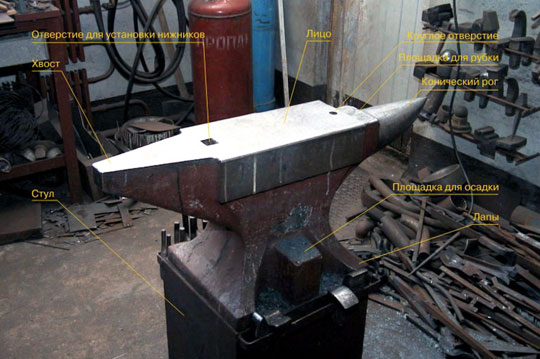
Modern anvils are made from tool steel by casting. The most convenient in work is a two-horned anvil. The upper horizontal platform is called the face; all the main blacksmithing operations are performed on it. The surface of the face must be well polished and kept in perfect condition: without dents, potholes and notches. Never tap the face of an anvil in vain with a hammer, do not chop metal on it with a chisel. On the right side of the anvil there is a conical horn designed for bending strips and bars, rolling and welding rings. On some anvils between the horn and the face there is an intermediate unhardened rectangular platform designed for cutting workpieces. On the left side there is a tail, which is a rectangular pyramid and is designed for bending and straightening rectangular closed blanks. The tail of the anvil has a square hole measuring 30x30 mm or 35x35 mm, designed to install backing tools, bending forks and other devices. On the face, near the conical horn, there is a round hole with a diameter of 12-16 mm, which is used for bending round bars. At the bottom of the anvil there are four paws, for which it is fastened with brackets to a block of wood or a metal stand.
Sometimes between two paws on the side plane there is a massive protrusion with a horizontal platform, which is used for upsetting bars. The anvil is installed on a massive wooden block (chair) made of oak or birch with a diameter of 500-600 mm. The base of the chair is buried to a depth of at least 0.5 m, and the ground around is well tamped. The chair should stand strictly upright and not vibrate during operation. But setting an anvil on a wooden chair has some drawbacks. Firstly, the too large area of the base of the chair makes it difficult to come close to the anvil, secondly, the mounting brackets periodically become loose, and thirdly, the anvil mounted on a wooden chair makes a too high sound when it is struck with a hammer. I am working on a large homemade anvil weighing 150 kg. I'll tell you more about it. First, a metal box without a lid was made from a sheet 4 mm thick, while the inner horizontal dimension of the box exactly matched the size of the base of the anvil. I filled the box with sand and tamped it well, on top I put a metal sheet of the same thickness, which exactly fit into the box in size. An anvil was installed on the sheet, tightly pressed with special clamps. On the side surfaces of the box, I fixed several brackets into which you can insert various devices necessary during work. So there was no need for an additional table for an improvised tool. It turned out to be a massive structure, firmly standing on the floor. For greater reliability, I attached the box with anchors to the concrete floor.
For small work, special anvils are used - shperaks, which are made by forging from carbon steels, followed by hardening of the working surfaces. I want to note that at the present time to acquire a good blacksmith tool- a big problem: our industry does not produce anvils or other blacksmith tools. I advise you to look for him in the villages, in factories, in railway workshops.
A forge in which you will work and rejoice
The main stationary equipment of the forge is a chair forge vice. No forge is complete without them.
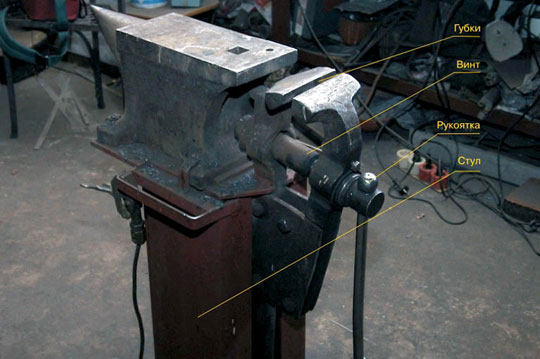
In a vice, blanks and various fixtures are clamped, bending, upsetting, cutting and many other operations are carried out. Chair vices come in a variety of sizes. They are usually mounted on a separate massive log - a chair, well fixed in the floor of the forge, next to the anvil. The top level of the jaws is at the same height as the face of the anvil. Chair vice jaws are forged from carbon steel 20, 25. If you could not get a chair vice, then at first you can get by with ordinary ones. A large bench or machine vise will do, but neither can withstand heavy impacts, as their bodies are cast iron.
In conclusion of the first lesson, I will give an example of the layout of a small forge (Fig. 2), the device of which, in addition to the forge, anvil and vice, includes a lot of different equipment. Tanks for coal, slag, water and oil are installed next to the mine, and racks for hand and underlay tools are attached to the walls. In addition, you need to do locksmith workbench, rack for metal, equip a place for welding work, install an electric grinder and all kinds of drawers and lockers for storage hand power tools, various devices and paintwork materials... And you will get a good forge in which you will work and rejoice.
It happens that you walk down the street, pass by some house or historical place, and notice unique masterpieces made of metal, whether it is someone's forged balcony, gate, architectural element, or just a free-standing sculpture created by the hands of an unknown master. Involuntarily think what skillful hands in humans, forcing an ordinary cold piece of iron to take an amazingly beautiful shape. And you yourself will want to learn forging.
A few words about history
At its core, it is a product made using metal processing, created for various purposes with inherent work of art properties. Since ancient times, people have sought to decorate objects used in everyday life with various distinctive signs. It is known that by appearance things often determined the status of the owner. As a rule, such things included goblets, armor, emphasizing belonging to a particular family, jewelry made of precious metals and, of course, swords and daggers with individual forged elements. Even in our time, when humanity is striving for practicality and minimalism, objects artistic forging often become a unique interior detail and the pride of the owner.
Metal work
Anyone who has some strength and love for this material can be trained to work with metal. If earlier it was not possible to complete a full course of study at a specialized educational institution, now there is always the opportunity to take lessons from practicing craftsmen who have considerable experience in artistic forging.
Now, in the days of the Internet, you can always watch a lot of videos with the metalworking process, purchase video tutorials or view them directly on sites. And yet, it is recommended to contact the master personally with the question of studying, because, thus, there is an additional opportunity for individual training to gain additional knowledge and learn the secrets of creating unique things that came to a professional with accumulated experience by trial and error, which no video tutorials for mass viewing will never be revealed.
Learning process
In order to start learning, you can preview the proposed information about this process to make sure that there is a desire to learn exactly forging, and to understand what will be required during the study. Any video on this material is initially devoted to the requirements for the equipment necessary for work on artistic forging. It should be understood that forging requires a lot of time for yourself, and the first time it may not work out.
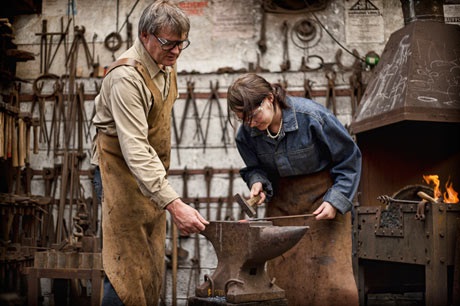
All lessons on teaching forging tell about the basics of working with metal. From them you can get information about preparing for the start of work, about the necessary tools and material needed to create this or that object, about the features of working with various types metals. Each metal requires an individual approach, since when creating a certain object from different metals, different temperatures are required, the force applied at. Some videos consist of cycles of detailed lessons that talk about all these nuances.
Next, you should find a professional master of his craft, so that he clearly demonstrates the possibilities of the profession. In the process of training, the blacksmith will not only talk about the theory and show already created objects, however, with a more serious approach and the student has a sincere interest in such a difficult matter, he will share his unique experience, at the same time telling about his rather curious mistakes that occurred during his training.
It is believed that personal communication with the master during the lessons is much more beneficial than watching videos hundreds of times or reading books on blacksmithing, since it is possible to correct the mistakes made immediately when they occur, to test the knowledge gained directly in practice under the strict guidance of the teacher. As you know, having received the first results of your work, it is already impossible to stop there.
Unfortunately, like any training, art forging requires material costs from the learner. It is worth considering this important factor before starting your studies. I would not like that interest in working with artistic forging and blacksmithing was generally interrupted due to the inability to acquire a certain essential tool for the manufacture of the desired element or because of the search for funds for a metal suitable for the task.
One way or another, if you feel the strength in yourself and there are opportunities for learning blacksmithing, then any masterpieces will be on your shoulder, and there will always be connoisseurs of objects created by a new hand of such unique art as artistic forging.
There are many options for learning to be a blacksmith. Courses, educational institution, self-study. Which of the options is the best? And also about where to get trained as a hand-forged blacksmith right now.
Everyone imagines what a hand-forged blacksmith does, learning this ancient craft many would like to pass, but how to do it in the 21st century? Even 100 years ago, everything was clear where the forge was located, everyone in the village knew.
And where are the forges and their inhabitants now, how to find them, how to learn this beautiful and difficult business?
After people discovered iron and learned how to process it, the blacksmith profession appeared. Most household equipment and household items were made of metal. In addition, vital things - weapons and armor - were also metal. To make them, remarkable skill was required. High-quality weapons were fabulously expensive, more expensive than gold and jewelry, because life depended on quality. Also, weapons have always been a status item, the richer and more skillfully made, the more admiration and respect the owner received.
Naturally, blacksmiths have always been highly respected and wealthy members of society, training as a blacksmith was prestigious. To arrange your son as an apprentice to the master meant to secure his future. It was not so easy, usually blacksmithing was a family business. In this regard, everything is much simpler now. Blacksmith training can be found, as they say, for every taste, for a person with any skills and work experience.
Blacksmith Training Requirements
We can say that the main condition for getting a profession is a conscious desire to get it. Not every blacksmith graduated from high school to become a cool master. Sometimes this is due to hard work and desire for self-education. However, there are three ways to become a blacksmith.
The first is to graduate from high school. Specialty Artistic forging is available in many Moscow universities and vocational schools.
The second is to go to blacksmith training, or take courses and further improve yourself.
The third is to reach everything with your own mind with the help of literature and training videos.
We can say that more or less universal way to be trained as a blacksmith is the second. Although each master has his own way, and there are no unambiguous recipes that lead to success one hundred percent. As mentioned above, the main recipe for success is your desire to learn.
Blacksmith training courses
Blacksmith courses can be easily found in such a big city as Moscow. For example, the Russian Academy of Crafts, an association of caring craftsmen, conducts courses on teaching various traditional craft techniques. There is a course "Blacksmith of Artistic Forging" at the Academy, with a training period of 3 months. You can choose a weekday (evening) or weekend group. Blacksmith training here is quite dense, 10-12 hours a week, in total - 144 hours. The cost of the course is 55,000 rubles. Upon graduation, graduates receive a diploma, an assigned category and the opportunity to rent a production facility.
Sample blacksmith training plan
Using the example of a training program from the Russian Academy of Crafts, let's see what you can learn in the courses. Not much time is devoted to theory, mainly, attention is paid to practice, training is carried out progressively. At the first lessons, students are told about the profession, they are introduced to the rules of labor protection and safety at work. They dedicate to the basics of materials science, drawing and design, introduce the history of various styles in forging. Then the students get acquainted with the tools, working materials, forge equipment. Next comes the turn to try out the basic blacksmithing operations in practice, making various forged objects, the students learn everything they need.
Cherry making. Forging a ball from a metal bar of square section, drawing, dispersing, applying texture to the metal surface, assembling are being mastered.
Making a door stop in the form of a snail. In the process of implementation, the skills of the main blacksmithing operations are fixed, auxiliary ones are mastered.
A more difficult stage is forging a horseshoe. Familiarization with the features of forging spikes, forming a groove and sewing holes for nails.
Making a candlestick. Students learn how to torsion forgings with a variable cross section, learn how to form spherical surfaces with the help of underlays, and how to assemble forged parts by riveting. Also, attention is paid to the methods of surface finishing - brushing, painting, embossing, patination. Mastering the techniques of forge welding.
Crowns the blacksmith's training to craft a forged item as thesis(for assignment from the category).
A student “with hands” will easily master the basics of forging during the course. But this is only the beginning, it cannot be said that after such training, the output is a ready-made master. Rather, a blank for the master. To become a real craftsman, you will have to work hard and further, study and study.











Chocolate biscuit: the secrets of cooking in a slow cooker and oven
Chemical composition and nutritional value
Apple chips at home
Braised cabbage with white beans, recipe
How to reduce the ass, hips and stomach at home?